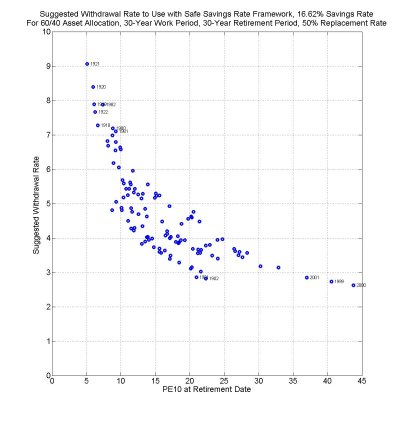When using a net worth/portfolio amount in Firecalc or other retirement calculators I use a method for valuation to account for market flucuations. I'd appreciate feedback from the group on its usefulness and validity.
At any point in time my actual net worth value may be too high or low because the market is valued too high or too low. In other words, if the market is at an alltime high then my net worth is probably overvalued. Conversely, if the market is well under the alltime high then my net worth is probably undervalued.
I use the S & P 500 as my index and 90% as my real percent value. So if the S&P 500 index is at an alltime high I multiply my net worth by .9 to calculate my real value to input into Firecalc. Conversely, if the S&P index is 20% lower than the alltime high then I multiply my net worth by 1.125 (the multiplier needed to get to 90%) to determine the real value of my net worth.
Scenarios - If my net worth is 1000 and:
- the S&P 500 index at alltime high then my actual net worth is multiplied by .9 so my real net worth equals 900
- the S&P 500 index is at 90% of the alltime high then my real net worth equals my actual net worth at 1000
- the S&P 500 index is only 80% of the alltime high then my actual net worth is multiplied by 1.125 so my real net worth equals 1125
my goal is to use a useful number for valuing net worth. Does this make sense? Is 90% the right percentage? Is the S&P 500 the right index?
At any point in time my actual net worth value may be too high or low because the market is valued too high or too low. In other words, if the market is at an alltime high then my net worth is probably overvalued. Conversely, if the market is well under the alltime high then my net worth is probably undervalued.
I use the S & P 500 as my index and 90% as my real percent value. So if the S&P 500 index is at an alltime high I multiply my net worth by .9 to calculate my real value to input into Firecalc. Conversely, if the S&P index is 20% lower than the alltime high then I multiply my net worth by 1.125 (the multiplier needed to get to 90%) to determine the real value of my net worth.
Scenarios - If my net worth is 1000 and:
- the S&P 500 index at alltime high then my actual net worth is multiplied by .9 so my real net worth equals 900
- the S&P 500 index is at 90% of the alltime high then my real net worth equals my actual net worth at 1000
- the S&P 500 index is only 80% of the alltime high then my actual net worth is multiplied by 1.125 so my real net worth equals 1125
my goal is to use a useful number for valuing net worth. Does this make sense? Is 90% the right percentage? Is the S&P 500 the right index?
Last edited:

